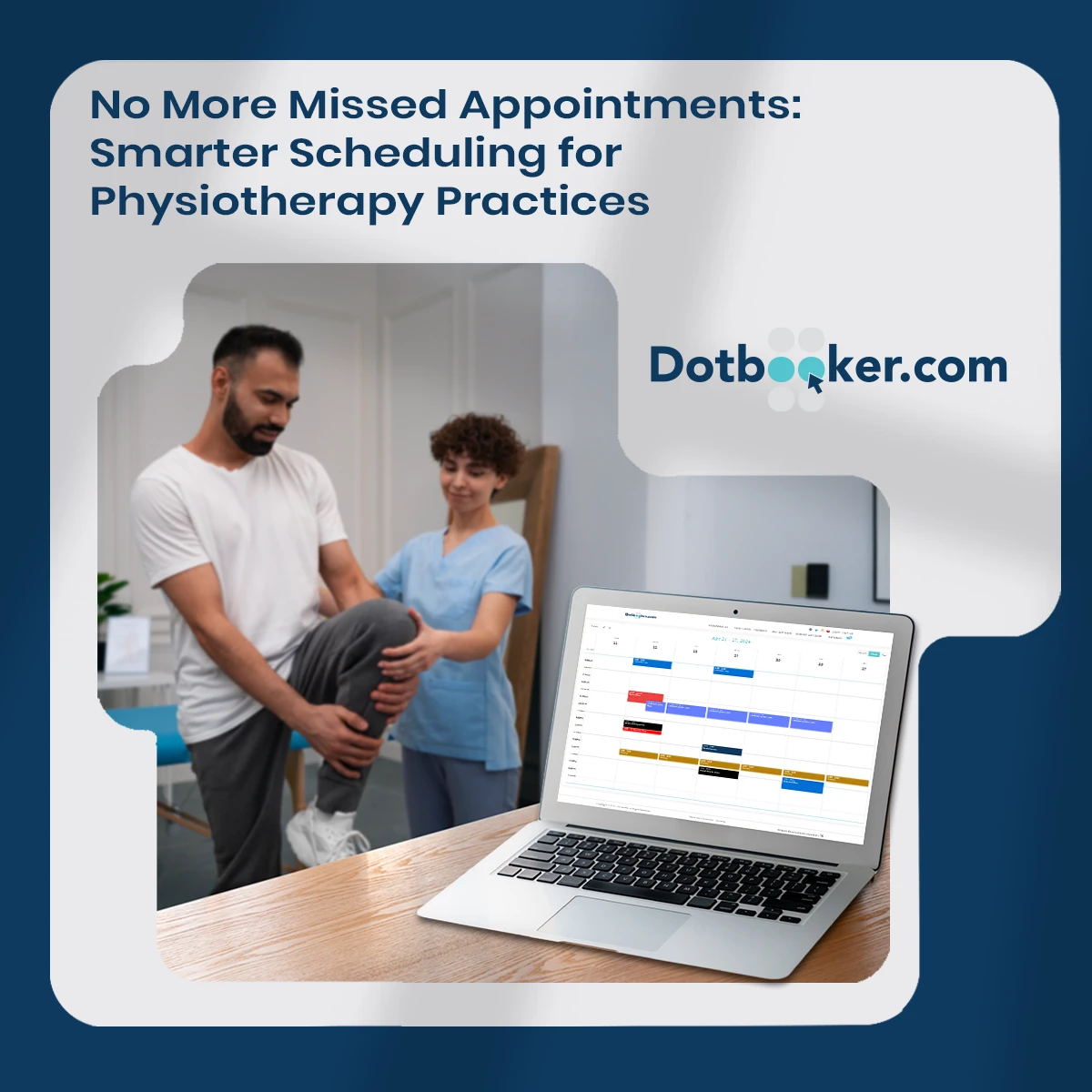
- By Dotbooker
- Jul 21, 2025
- 507
No More Missed Appointments: Smarter Scheduling for Physiotherapy Practices
It All Starts with a Missed Appointment
It’s 9:00 a.m. Your patient doesn’t show up.
Another empty slot. Another awkward conversation with your receptionist. Another hour of potential therapy… gone.
But let’s rewind. What if that patient had received a timely reminder? What if they could’ve easily rescheduled with a few taps? What if—just what if—your system was smarter?
That’s the question that modern physiotherapy practices are starting to ask. And the answer is becoming clearer: it’s time to stop scheduling as if it were still 2005.
The Problem Isn’t Just People. It’s the Process.
Let’s be honest—patients don’t want to miss appointments. But between work, kids, traffic, and forgotten reminders, things slip through the cracks. And when your practice is juggling dozens of sessions a day across multiple therapists, even one missed appointment creates a domino effect.
The result?
- Disrupted therapist flow
- Wasted resources
- Lost revenue
- And worst of all, patients falling off their recovery track.
The issue isn’t human error. It’s the lack of intelligent systems behind the scenes. And that’s where physiotherapy practice management software quietly becomes the hero.
The Real Impact of Missed Appointments in Physiotherapy
A missed appointment may seem minor, but in the world of physiotherapy, it can disrupt the entire rhythm of recovery.
Here’s how those missed or poorly managed sessions affect your clinic:
- Delayed Recovery Plans: Many physio treatments rely on progressive improvement—missing even one session could require retracing steps or starting over.
- Drop in Patient Commitment: Inconsistent sessions can demotivate patients, especially when they start to feel they’re not making progress.
- Therapist Burnout: Last-minute cancellations or poor scheduling often lead to gaps or overcrowding, both of which can exhaust your staff.
- Revenue Leakage: Every no-show equals not just lost income for that session, but potential downstream losses from incomplete treatment plans.
- Frustration in the Front Office: Constant rescheduling, chasing patients for confirmations, or manually adjusting calendars eats up admin bandwidth.
It’s a domino effect that starts with a simple oversight and ends with dissatisfied patients and drained teams.
So, What Does “Smarter Scheduling” Actually Mean?
Let’s break the buzzword.
Smart scheduling isn’t just auto-filling a calendar—it’s about equipping your clinic with the ability to think, predict, and adapt in real time.
A powerful physiotherapy practice management software helps you do exactly that by:
- Eliminating repetitive manual work
- Streamlining communications with patients
- Syncing therapist calendars with patient preferences
- Handling no-shows, cancellations, and rebookings automatically
- Managing treatment plan timelines, room assignments, and therapist load
It’s like having an operations manager embedded into your software—one that never forgets, never delays, and never takes a coffee break.

Let’s dive deeper into what these tools offer.
1. Real-Time Booking and Therapist Availability Matching
Let’s face it—people book gym sessions, salon appointments, and even car maintenance online. So when it comes to healthcare, patients expect the same level of convenience, if not more.
Modern physiotherapy practice management software provides, eliminatings real-time booking that eliminates the guesswork forboth patients and stafe.
Here’s how it transforms the experience:
- Patients can browse live availability across therapists, locations, and service types, just like choosing a time slot on a food delivery app.
- Therapist calendars update instantly—if one gets booked, the system immediately reflects it across all platforms, avoiding embarrassing double-bookings.
- Filters by treatment type (e.g., manual therapy, dry needling, or postoperative rehabilitation) ensure that patients are matched only with qualified professionals.
- Location-aware booking enables patients to choose their preferred branch or provider, ideal for multi-location clinics. Moreovere, therapists no longer have to toggle betweentheir personal and work calendars. Bookings can be:
- Synced with Google Calendar, iCal, or Outlook
- Color-coded by session type
- Automatically blocked during time-off or holidays.
No more whiteboards. No more “Who’s free tomorrow?”
Just precise, digital scheduling that runs 24/7—even while your clinic is closed.
2. Recurring Appointments for Long-Term Plans
Rehabilitation is a marathon, not a sprint—and smart clinics know that continuity of care is essential.
Most physiotherapy treatment plans involve 6–12 sessions spread over weeks or months.
Without automation, booking each visit manually is not only tedious, but also error-prone. That’s where recurring appointment features shine.
Here’s what you can do with advanced scheduling software:
- Set a session cadence (e.g., every Monday, Wednesday, and Friday at 10:00 a.m.) for the entire treatment duration.
- Block the same room and therapist in advance to reduce logistical mix-ups.
- Customize each recurrence—adjust durations, insert rest weeks, or skip public holidays automatically.
- Integrate with patient alerts to ensure they receive a comprehensive session roadmap from day one.
This enables your staff to plan therapist workloads, flag potential conflicts early, and enhance the overall clinical rhythm of your practice.
It also increases patient commitment. When they see their recovery mapped out on day one, they’re far more likely to stick with the program and show up on time.
3. Automated Reminders (That Reduce No-Shows)
Let’s be honest—forgetfulness is human. And while your team can’t call every patient the day before, your physiotherapy scheduling software absolutely can.
The most effective platforms use multi-layered, omnichannel reminders that reach patients where they’re most active:
- SMS for instant visibility
- Email for detailed instructions or documents
- Push notifications if you have an app.
- WhatsApp or Messenger integration for clinics that serve younger, tech-savvy clients
The process typically works like this:
- 24–48 hours before the appointment: Patient receives a "friendly reminder" with time, location, and therapist info.
- 2–3 hours before: A short reminder for last-minute preparation or confirmations.
- Optional links for rescheduling or confirming attendance—so your system always knows what’s happening.
Some systems also allow customization of reminders based on service type. For example:
- A high-risk patient might receive extra reminders.
- A new patient might be sent an intake form along with the reminder.
- Pediatric sessions might include notes for parents.
By automating this follow-up chain, clinics typically reduce no-shows by 30–50% within the first 2 months.
And perhaps more importantly, patients begin to trust your clinic’s attention to detail, which enhances loyalty and perception.
4. Intelligent Waitlists That Fill Cancellations Automatically
Cancellations are inevitabldue to e—illness, emergencies, or simple schedule conflicts. But cancellations don’t have to mean lost time or money.
With intelligent waitlists, your system can:
- Track open slots the moment a cancellation occurs
- Automatically scan the waitlist for the best-fit patients (based on location, session type, therapist match)
- Send alerts to multiple waitlisted patients in priority order.
- Allow instant slot confirmation—first come, first served
Imagine this:
A 5 p.m. slot opens. Your system notifies two nearby patients who were on hold for next week. One clicks “Accept,” and the spot is filled, without your teamhaving to dog a thing.
Even better? These waitlists are:
- Dynamic: They update based on patient preferences and urgency
- Permission-based: Patients can opt in or out of being on standby.
- Smartly filtered: Only patients eligible for the same treatment type and location are contacted.
The result?
More appointments fulfilled. Fewer idle hours. Better access for patients in need.
5. Resource, Room & Equipment Management
If you've ever scheduled three manual therapy sessions at once and realized you’ve only got two available rooms, you know the pain of resource conflicts.
Physiotherapy isn’t just about time—it’s about space and tools.
Modern software ensures that:
- Room booking is integrated with session scheduling
- Each therapist’s schedule is cross-checked against room and equipment availability.
- Equipment (e.g., resistance bands, ultrasound machines, electrotherapy kits) is tagged and tracked to prevent overlap.s
This is especially crucial for:
- High-traffic practices that operate across multiple rooms or branches
- Specialized treatments that require certain tools or temperature-controlled spaces
- Clinics that rent space to independent therapists
Admins can access visual dashboards that show room occupancy and therapist assignments, helping them avoid bottlenecks or overuse of a specific resource.
The result is a smoother patient experience, a more predictable workflow, and higher utilization of every inch of your clinic.

6. Therapist-Centric Features That Respect Human Limits
Behind every successful physio session is a real person—a therapist juggling back-to-back patients, documentation, and often physical strain.
Good scheduling software doesn’t just serve the business. It protects the people who make healing happen.
With therapist-centric tools, you can:
- Set buffer times (5–15 minutes) between sessions for charting or short breaks
- Configure maximum appointments per day/week, especially for specialized or high-demand staff
- Create custom availability patterns—for example, morning-only shifts, alternating weeks, or part-time therapists.
- Let therapists block off personal or professional development time directly in the system.
Even skill-matching algorithms can come into pl, y—where the system suggests therapist-patient pairings based on treatment type, past success rates, or even language preferences.
Why does this matter?
Because burned-out therapists lead to rushed care, higher error rates, and lower patient satisfaction.
By respecting limits and supporting flexibility, your software contributes directly to a healthier, more engaged team—and ultimately, better treatment outcomes.
The Final Stretch: Your Practice Deserves Better Time Management
In physiotherapy, every session is a step toward healing.
Every no-show, every last-minute shuffle, every scheduling conflict—it slows down someone’s recovery journey. In the process, it also hurts your clinic’s efficiency and growth.
That’s why investing in intelligent physiotherapy scheduling software is about more than just logistics. It’s about reclaiming your clinic’s time, focus, and care capacity.
And if you’re looking for a solution designed specifically for modern physiotherapy and wellness businesses, Dotbooker is a platform worth exploring.
Dotbooker offers:
- Advanced scheduling with multi-location and therapist support
- Recurring session logic
- Waitlists, auto-notifications, and mobile-friendly patient portals
- Seamless integration with payments, packages, and class sessions
Whether you’re managing a growing physiotherapy clinic or offering blended services like chiropractic or massage, Dotbooker helps you run smarter, book better, and serve faster—all without missing a beat.
So maybe it’s time to ask yourself:
Is your schedule serving your practice—or sabotaging it?
Popular Blogs

- Oct 20, 2022
- 4744

- Sep 08, 2024
- 4069

- Nov 11, 2022
- 3509

- Sep 16, 2024
- 2886
Transform your business now!

Get an expert consultation for your business's streamlined operations.